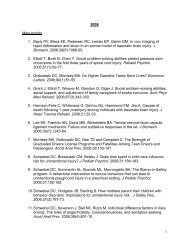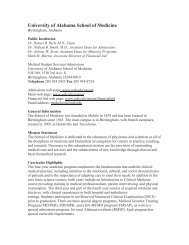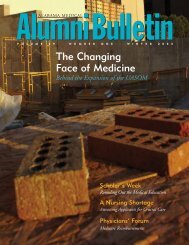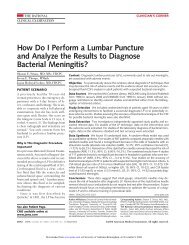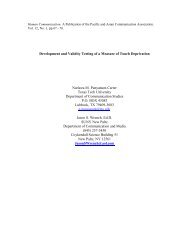AlumniBulletin - The University of Alabama at Birmingham
AlumniBulletin - The University of Alabama at Birmingham
AlumniBulletin - The University of Alabama at Birmingham
Create successful ePaper yourself
Turn your PDF publications into a flip-book with our unique Google optimized e-Paper software.
It’s a complex issue, and one th<strong>at</strong> can be approached from any<br />
number <strong>of</strong> angles. At its core, however, is the issue <strong>of</strong> tort reform.<br />
Trial lawyers claim th<strong>at</strong> p<strong>at</strong>ients shouldn’t be limited in the<br />
amount <strong>of</strong> damages they can receive through litig<strong>at</strong>ion. Insurers<br />
say they are forced to raise their premiums in order to protect<br />
themselves against large jury awards th<strong>at</strong> sometimes reach into the<br />
millions. And physicians say they’ve been left footing the bill since<br />
reimbursement r<strong>at</strong>es are set and their escal<strong>at</strong>ing premium costs<br />
can’t be covered by raising fees for their services.<br />
One thing’s for sure, though: <strong>The</strong>re is a crisis looming, and it<br />
must be addressed before the health-care delivery system in this<br />
country is seriously compromised.<br />
UNDERSTANDING INSURANCE<br />
While huge jury awards in medical-liability<br />
cases are the main reason for the rise in premium<br />
costs for physicians, there are other contributing<br />
factors, according to Richard B. Morawetz, M.D.,<br />
pr<strong>of</strong>essor and director <strong>of</strong> the Division <strong>of</strong> Neurosurgery<br />
in the School <strong>of</strong> Medicine <strong>at</strong> UAB.<br />
“<strong>The</strong> insurance business is pretty straightforward,”<br />
says Morawetz. “<strong>The</strong> insurance companies<br />
collect premiums, and they invest those premiums<br />
in the stock market in an effort to gener<strong>at</strong>e enough<br />
income to pay claims with money left over—<br />
which represents their pr<strong>of</strong>it.” <strong>The</strong> bull market <strong>of</strong><br />
the nineties resulted in lower insurance premiums<br />
across the spectrum since insurers’ stock-market<br />
investments were showing healthy returns.<br />
But then three things happened. “First there<br />
was a downturn in the stock market in 2000,”<br />
says Morawetz, “and then 9/11 occurred in 2001,<br />
and in 2002 there were severe floods in central<br />
Europe,” explaining th<strong>at</strong> because many insurance<br />
companies are intern<strong>at</strong>ional, they are affected by<br />
European financial conditions. “<strong>The</strong>se three factors<br />
resulted in a substantial reduction in the insurers’<br />
reserves, and they had to increase their premiums<br />
substantially to make up for th<strong>at</strong> loss.”<br />
Morawetz notes th<strong>at</strong> he and his colleagues, as<br />
physicians practicing <strong>at</strong> a major hospital and medical<br />
teaching institution, share the frustr<strong>at</strong>ions <strong>of</strong><br />
doctors in priv<strong>at</strong>e practice. “At the university, premiums<br />
are paid by the departments on behalf <strong>of</strong> the<br />
physicians,” he says, “but these fees still come out <strong>of</strong><br />
practice income, just as they do in priv<strong>at</strong>e practice.”<br />
Unlike automakers, for instance, who can pass<br />
higher m<strong>at</strong>erial or manufacturing costs along to<br />
their customers, physicians are forced to absorb<br />
the cost <strong>of</strong> rising insurance premiums. “Because<br />
<strong>of</strong> the way reimbursement for medical services is<br />
set up, physicians can’t just decide to charge more<br />
for their work,” says Morawetz. “So the decline in<br />
the stock market—along with high jury awards in<br />
liability cases—caused premiums to rise to really<br />
unsustainable levels. Many physicians around the<br />
country are no longer able to afford insurance.<br />
Some have decided to practice without insurance,<br />
some have been driven into personal bankruptcy,<br />
and others have simply left practice entirely.”<br />
One way to correct this imbalance would be<br />
setting reimbursement r<strong>at</strong>es by the market, r<strong>at</strong>her<br />
than by third parties, Morawetz says. “<strong>The</strong>re’s an<br />
aberr<strong>at</strong>ion right now in th<strong>at</strong> these costs are being<br />
borne only by physicians who simply can’t pay<br />
them,” he says. “And if this issue is not dealt with<br />
in the next two or three years, the n<strong>at</strong>ional system<br />
<strong>of</strong> medical care will begin to unravel.”<br />
PATIENTS ULTIMATELY PAY<br />
Of all the medical specialties and subspecialties,<br />
neurosurgery and obstetrics and gynecology<br />
are subject to the highest liability premiums.<br />
Michael Poist, M.D., an OB/GYN who has practiced<br />
in Tuscaloosa since 1991, has done his best<br />
to keep his payments as low as possible.<br />
7<br />
“Most medical liability companies <strong>of</strong>fer continuing<br />
medical-educ<strong>at</strong>ion courses th<strong>at</strong> deal with<br />
document<strong>at</strong>ion and p<strong>at</strong>ient communic<strong>at</strong>ion skills,<br />
and you get a little shaved <strong>of</strong>f your premiums by<br />
<strong>at</strong>tending,” he says. “But it’s not much.”<br />
Even with this slight reduction, however, Poist has<br />
seen his payments rise by about 15 percent in recent<br />
times, and increases <strong>of</strong> as much as 30 percent reportedly<br />
are on the horizon. He points out th<strong>at</strong> the<br />
American College <strong>of</strong> Obstetricians and Gynecologists<br />
has issued a “red alert” for 13 st<strong>at</strong>es, and has placed<br />
<strong>Alabama</strong>—along with five other st<strong>at</strong>es—in a “brewing<br />
crisis” c<strong>at</strong>egory. While this news certainly does not<br />
bode well for physicians, Poist says the price will ultim<strong>at</strong>ely<br />
be paid by p<strong>at</strong>ients.<br />
“Wh<strong>at</strong> many people don’t realize is th<strong>at</strong> the<br />
increased cost <strong>of</strong> liability insurance will eventually<br />
transl<strong>at</strong>e to higher medical costs overall,” he<br />
says. “And with physicians retiring early, or moving<br />
to areas where premiums are lower, this will<br />
have a dram<strong>at</strong>ic impact on the p<strong>at</strong>ients’ ability to<br />
access the medical care they need.”<br />
Access is indeed the central concern, says J.<br />
Noble Anderson Jr., M.D., an otolaryngologist<br />
who practices in Montgomery. “If doctors are<br />
going out <strong>of</strong> business because they can’t afford to<br />
pay their liability insurance premiums, then who<br />
loses?” he asks. “<strong>The</strong> p<strong>at</strong>ients do. Th<strong>at</strong>’s why it’s<br />
a m<strong>at</strong>ter <strong>of</strong> access to medical care.”<br />
Anderson points out th<strong>at</strong> a priv<strong>at</strong>e practice—and<br />
some 85 percent <strong>of</strong> the physicians in <strong>Alabama</strong> are<br />
priv<strong>at</strong>e practitioners—is basically a small business,<br />
with all <strong>of</strong> the associ<strong>at</strong>ed expenses, such as salaries for<br />
“<strong>The</strong>re’s an aberr<strong>at</strong>ion right now in th<strong>at</strong> these costs<br />
are being borne only by physicians who simply<br />
can’t pay them. And if this issue is not dealt with in the<br />
next two or three years, the n<strong>at</strong>ional system <strong>of</strong> medical<br />
care will begin to unravel.”<br />
— Richard Morawetz, M.D.<br />
employees and rent and utility costs. “Insurance is<br />
factored into a practice’s overhead,” he says. “In<br />
addition to having to pay more for insurance, utility<br />
r<strong>at</strong>es go up, the cost <strong>of</strong> living increases, and employees<br />
want raises. As a result, physician practices are<br />
having a harder time breaking even these days.”<br />
One way in which some physicians are lowering<br />
premiums—and thus overhead—is by deciding<br />
not to perform certain “high-risk” procedures.<br />
“Insurance companies <strong>at</strong>tach different risk values<br />
to different procedures, and every year they send<br />
out a sort <strong>of</strong> checklist, and you indic<strong>at</strong>e wh<strong>at</strong> you<br />
do and don’t want to do on th<strong>at</strong> list. Th<strong>at</strong>’s just<br />
one <strong>of</strong> the ways they determine wh<strong>at</strong> your liability<br />
coverage will cost,” says Anderson. “I practice<br />
general otolaryngology, and I stopped doing facial



